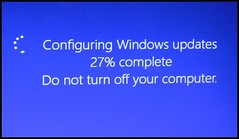I had a friend tell me that Microsoft is now automatically upgrading everyone to Windows 10. Is this true and if so, is there anything I can do to stop it?
This question was answered on February 19, 2016. Much of the information contained herein may have changed since posting.
 It’s no secret that Microsoft wants the world to switch to Windows 10 and making it a free upgrade has certainly kick started this initiative.
It’s no secret that Microsoft wants the world to switch to Windows 10 and making it a free upgrade has certainly kick started this initiative.
Microsoft continues to tout impressive statistics, such as ‘it’s the fastest growing operating system ever’ or ‘it’s now installed on over 200 million systems’ but the reality is that most of you are still running Windows 7.
The most recent NetMarketShare (https://netmarketshare.com) data still shows Windows 7 with over 50% of the market share with Windows 10 now taking second place with just under 12% in worldwide market share:
Windows 7 - 52.47%
Windows 10 - 11.85%
Windows XP - 11.42%
Windows 8.1 – 10.40%
Mac OS X 10.11 – 3.44%
(Related: Windows 10 Deleted My Files!)
If you’re still running Windows 7 or 8.1 and have no interest in upgrading to Windows 10, it’s important to understand why the rumors of a ‘forced upgrade’ are going around.
Microsoft is not forcing automatic upgrades, but they did recently change the Windows 10 upgrade from an ‘optional upgrade’ to a ‘recommended upgrade’, which is why some people are claiming an automatic upgrade.
What’s actually happening is that anyone whose update settings treat recommended updates the same as important updates will get it automatically on the next automatic update cycle.
To check this setting in Windows 7, go to the Windows Update utility in the Control Panel (or search for it from the Start button).
In the left panel, click on Change Settings and remove the checkmark from the ‘Give me recommended updates that same way I receive important updates’.
In Windows 8.1, go to Settings, then Change PC settings and click on the ‘Update and recovery’ option and follow the ‘Choose how updates get installed’ link.
(Related: Windows 10 Known Issues So Far)
Despite the horror stories that are common online or in social media, the Windows 10 upgrade process goes relatively smoothly, in most cases.
The biggest mistake that most people make when upgrading is assume that when the initial process is completed, they are all done.
There are lots of things that need to be addressed after the initial install, including making sure all your drivers are updated, especially for things like video cards, networking cards and printers.
Microsoft will also remove programs that they believe would cause problems, such as third-party utilities or really old software programs.
They will also remove anti-virus/anti-malware programs that aren’t compatible or have expired and replace them with Windows Defender.
Older programs are also a known issue, such as Office 2003 (especially if you want to use Outlook), which is why doing a comprehensive review of your computer hardware and software before upgrading to Windows 10 is highly recommended.
Microsoft does offer you the ability to revert to your previous version of Windows if you don’t like Windows 10, but you only have 30 days to do so.
As a precaution, we generally make an image copy of the system before performing the upgrade in our shops, so we have complete control over the reversion if it’s necessary.
(Image courtesy of https://www.flickr.com/photos/87249144@N08)
About the author
Posted by Ken Colburn of Data Doctors on February 19, 2016
Need Help with this Issue?
We help people with technology! It's what we do.
Contact or Schedule an Appointment with a location for help!

